FOR ADVERTISING
CONTACT:
Prem Dutt: Email
Call Prem: (916) 743-8316
Seema Gupta: Email
Call Prem: (408) 745-9663
|

|
EDITORIAL:
Nuclear Nightmare
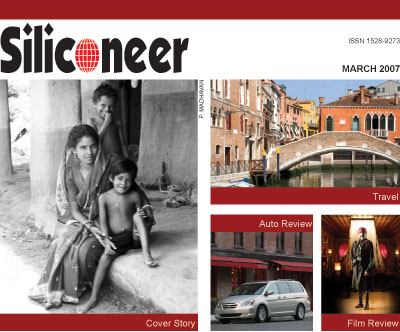 Thanks to the spectacular IT boom, global outsourcing of jobs and a brisk economic growth rate, the Western perception of India — and the perception of its own elite, one may add — has changed. But Shining India or not, it’s still a land of contrasts. It’s true that members of India’s elite — and its Indian American cousins up here in the U.S. — are basking in an unfamiliar wave of global awe as they enthusiastically join in a frenzy of celebration. Thanks to the spectacular IT boom, global outsourcing of jobs and a brisk economic growth rate, the Western perception of India — and the perception of its own elite, one may add — has changed. But Shining India or not, it’s still a land of contrasts. It’s true that members of India’s elite — and its Indian American cousins up here in the U.S. — are basking in an unfamiliar wave of global awe as they enthusiastically join in a frenzy of celebration.
But hold on the champagne just yet.
There may be a new gloss to the latest economic figures, but the old demons seem to die hard. India’s millennial curse — its shocking socio-economic disparity — is alive and kicking.
Nothing underscores this more graphically than the recent disaster in Jadugoda.
The recent disaster where, the reader may blankly ask. And that’s precisely the point. If a few IT workers get killed in a metropolitan city, it’s big news for the desis, but since this happened in an unheard-of town in the backward state of Jharkhand, nobody cares.
While Indians all over the world were still celebrating the historic Indo-U.S. nuclear deal, on Dec. 24 last year, thousands of liters of radioactive waste spilled in a creek after a pipe burst at a Uranium Corporation of India Limited facility.
The recent accident is only the latest example of UCIL’s callousness, and in this month’s cover story Sunita Dubey takes a closer look at a long history of negligence and apathy and its terrible health consequences to the underprivileged people who have had the misfortune of being UCIL’s neighbors.
Living in the West, while one marvels at the continuous news of technological innovation, there does lurk, somewhere in the deeper recesses of the desi conscience, a nagging misgiving that very little of it is relevant to the bulk of the population in the old country, the rural poor.
What wonderful news, then, that the National Academy of Engineering in the U.S. invited solutions to one of the more harrowing environmental health challenges facing South Asia today. Tens of millions of people in the Indian state of West Bengal and its neighbor Bangladesh are slowly being poisoned by the water they drink, because it has arsenic in it.
NAE’s criteria were astute: The solutions must be affordable, reliable, easy to maintain, socially acceptable, and environmentally friendly.
George Mason University chemistry Prof. Abul Hussam won the $1 million first prize for a simple but effective filter. A top bucket is filled with locally available coarse river sand and a composite iron matrix. The sand filters coarse particles, while the CIM removes inorganic arsenic. The water then flows into a second bucket where it again filters through coarse river sand, then wood charcoal to remove organics, and finally through fine river sand and wet brick chips to remove fine particles. The filter to date has supplied over a billion liters of arsenic-safe water to village communities.
Lehigh University chemical engineering Prof. Arup SenGupta and his team won the $200,000 second prize for a system that is applied at typically a hand-pumped well. Each unit serves about 300 households. Water is hand-pumped into a fixed-bed column, where it passes through activated alumina or hybrid anion exchanger to remove the arsenic. After passing through a chamber of graded gravel to remove particulates, the water is ready to drink. This system has been used in 160 locations in West Bengal, India. We salute these two scientists for marrying science to society in such a far-reaching, beneficial and vital manner.
Regular readers may do a double-take when the look at this month’s issue. How is it that we are doing another article on an exhibit of Rajasthan’s art right after we put it on the cover last month?
Our answer: This was too important an occasion to ignore. Rarely has it happened that two important events on India have happened simultaneously in the San Francisco Bay Area, but this is the case here.
Last month, an exquisite exhibit of Rajasthani arts and crafts opened at the Phoebe Hearst Museum of Anthropology at the University of California at Berkeley. So did a separate exhibit at the Asian Art Museum in San Francisco. This month we carry an in-depth article on the exhibit in San Francisco, which focuses on the art of Rajasthan’s Mewar, a fabled kingdom of heroism, chivalry and valor in the popular Indian imagination.
Eight years in the making, “Princes, Palaces, and Passion: The Art of India’s Mewar Kingdom,” presents 74 objects featuring art works ranging from the early sixteenth century to the early twentieth century, borrowed from important museum and private collections in Great Britain, Australia, and the United States.
And finally, we wish all our readers a very happy Holi.
Do drop us a line with ideas and comments about how we can make Siliconeer better serve you.
|TOP|
COVER STORY:
Toxic Fallout: Jadugoda's Nuclear Nightmare
The folks who are cheering over the Indo-U.S. accord on civil nuclear cooperation live a world away from Jadugoda, the Jharkhand village where India’s uranium mine is situated. It is these hapless villagers who continue paying a terrible price in terms of toxic health hazards after being made the sacrificial lambs of a government policy where jingoistic hubris trumps compassion or accountability, writes Sunita Dubey.
 (Left): Ironically, the name Jadugoda literally means “magic land.” Located in the Potka and Mosabani block of east Singhbhum district of Jharkhand, Jadugoda is 25 km from Jamshedpur. Home to the Santhali and Hotribes of Jharkhand, it also has a uranium mining facility that has had a catastrophic effect on the health of its residents. (Left): Ironically, the name Jadugoda literally means “magic land.” Located in the Potka and Mosabani block of east Singhbhum district of Jharkhand, Jadugoda is 25 km from Jamshedpur. Home to the Santhali and Hotribes of Jharkhand, it also has a uranium mining facility that has had a catastrophic effect on the health of its residents.
(Below, left): A child’s face says tells the horrific story of Jadugoda better than any bitter protest. Children have paid a heavy price for the toxic hazards posed by the callous and sloppy practices of a government-owned uranium mine. [ALL PHOTOS BY P. MADHAVAN]
“Whatever befalls the earth befalls the child of the earth. People did not weave the web of life; they are merely strands in it. Whatever they do to the web, they do to themselves”.
— A native American on uranium mining
The Indo-U.S. nuclear deal may be considered groundbreaking and historic by many in India and the United States, but this euphoria must not shroud the misery of thousands of people suffering the effects of uranium mining in India due to poor technical and management practices in existing mines.
 While major newspapers and television stations in India celebrated a major political victory by India as it covered the announcement of the Indo-U.S. deal, contrast this with an incident which happened Dec. 24. While major newspapers and television stations in India celebrated a major political victory by India as it covered the announcement of the Indo-U.S. deal, contrast this with an incident which happened Dec. 24.
Thousands of liters of radioactive waste spilled in a creek because of a pipe burst at a Uranium Corporation of India Limited facility at Jadugoda, India. It neither made newspaper headlines nor did UCIL come to know of the disastrous leak till alerted by the local villagers. Such are the realities of nuclear facilities in India.
Callousness of UCIL. The Dec. 24 accident is the latest example of UCIL’s callousness, which occurred in a small village inhabited largely by displaced families whose lands were acquired to construct two of the three storage dams, also known as tailings ponds. Based on the experience of similar accidents in other countries, the negative effects on human and environmental health will impact not just Jadugoda, but several communities living downstream, perhaps even hundreds of kilometers away.
UCIL had no alarm mechanism to alert the company in cases of such a disaster. Instead, the villagers who had arrived at the scene of the accident soon after the pipe burst informed the company of the toxic spill.
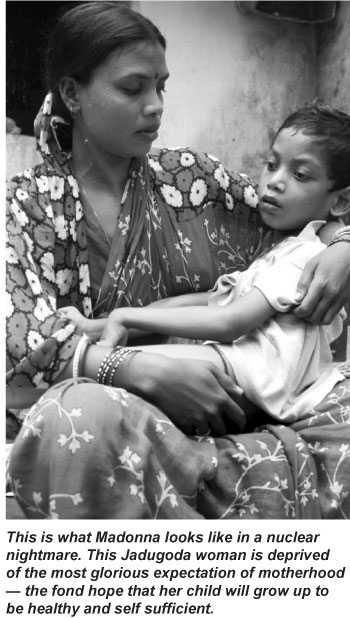 The toxic sludge spewed into a creek for nine hours before the flow of the radioactive waste was shut off. Consequently, a thick layer of toxic sludge on the surface of the creek killed scores of fish, frogs, and other riparian life. The waste from the leak also reached a creek that feeds into the Subarnarekha river, seriously contaminating the water resources of the communities living hundreds of kilometers along the way. This is not the first such accident. In 1986, a tailing dam had burst open and radioactive water flowed directly into the villages. The toxic sludge spewed into a creek for nine hours before the flow of the radioactive waste was shut off. Consequently, a thick layer of toxic sludge on the surface of the creek killed scores of fish, frogs, and other riparian life. The waste from the leak also reached a creek that feeds into the Subarnarekha river, seriously contaminating the water resources of the communities living hundreds of kilometers along the way. This is not the first such accident. In 1986, a tailing dam had burst open and radioactive water flowed directly into the villages.
A similar disaster in 1979 in the United States at Church Rock, N.M., had also left many people and their environment scarred for years altogether. More than eighteen months after the accident, there were strong indications that the radiation and other pollutants had penetrated 30 feet into the earth. A report by a Cincinnati-based firm brought in as a consultant by the EPA warned that at least two nearby aquifers had been put “at risk. “
According to Don Hancock of the Southwest Research and Information Center in New Mexico, though remediation/ clean-up in Jadugoda will depend upon local conditions, it is essential to monitor the situation very carefully. Some of the immediate steps which need to be taken include immediate sludge removal from the river bed, as river beds are usually very permeable. The communities downstream should also be warned to not use the water till it has been established to be safe. It can take several months for the water to become safe again.
India’s Navajo Nation. Since 1967, when UCIL first started uranium mining in Jadugoda, the lives of people have been inflicted with unknown diseases, deaths and poisoned environment. The foundation of these mines has been laid on lies and misinformation by UCIL about the impact of uranium mining, radiation and toxicity in Jadugoda. Till the ’90s the tailing ponds (where uranium mine liquid waste is stored to evaporate) was in close vicinity of areas in the villages used as children’s playground, open grazing area and other public use. The radiation levels and related sickness were never revealed by UCIL, even though for years the local population has suffered from the extensive environmental degradation caused by the mining operations which are also responsible for the high frequency of radiation-related sicknesses and developmental disorders found in the area. Even though India’s Atomic Energy Act states that there should be no habitation within five kilometers of a waste site or uranium-tailing pond and even though Jadugoda has been in operation for more than 30 years, seven villages stand within one and a half kilometers of the danger zone. One of them, Dungardihi, begins just 40 meters away.
Questioning Legitimacy. It was only in 1996 when a group of people working in the mines and living in close vicinity started questioning the legitimacy UCIL’s free rein to pollute the environment and lives of indigenous people. This led to the formation of a local anti-uranium mining group called Jharkhandis Organization Against Radiation whose mission is to resist further nuclear development, and to educate the local Adivasis about the dangers of radioactivity. JOAR is also a winner of the 2004 Nuclear-Free Future Resistance Award. Even after the documentation of severe damage caused by uranium mining in Jadugoda in a documentary titled “Buddha Weeps In Jadugoda” by Shri Prakash, UCIL still admits to no wrongdoing, claiming that none of the prevalent congenital diseases in the area are due to the radiation from their uranium mines and milling operations.
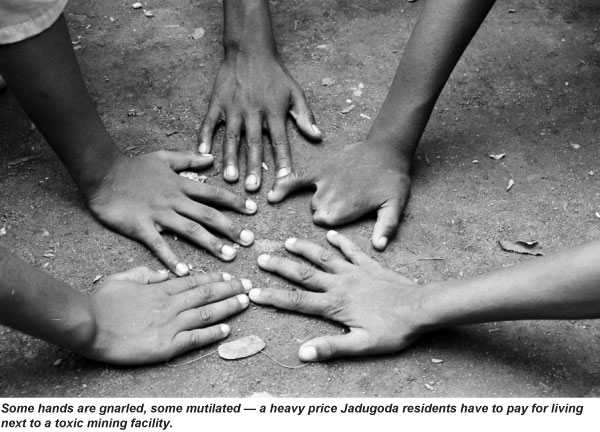
India’s Nuclear History. Until World War II, uranium was regarded as little more than a substance used to color ceramics and glass, a byproduct of radium production. However, since the discovery of nuclear fission in 1938, the international nuclear industry has produced more than 1.7 million metric tons of uranium in about 30 countries. The IAEA estimates that about 360,000 metric tons of natural uranium or about 20 percent of the world’s production has been used for military purposes.
India was the first Asian country to develop a nuclear program and the Atomic Energy Commission was set up in 1948, just one year after independence, followed by the Department of Atomic Energy in August 1954. The Indian nuclear program got a boost with U.S. and Canadian support in 1969, which was for research purposes, but with the same technology, India exploded its first plutonium bomb in 1974. This shows that even though the façade behind the nuclear program might be for power generation or research, at any given time the program can be turned into nuclear weapons.
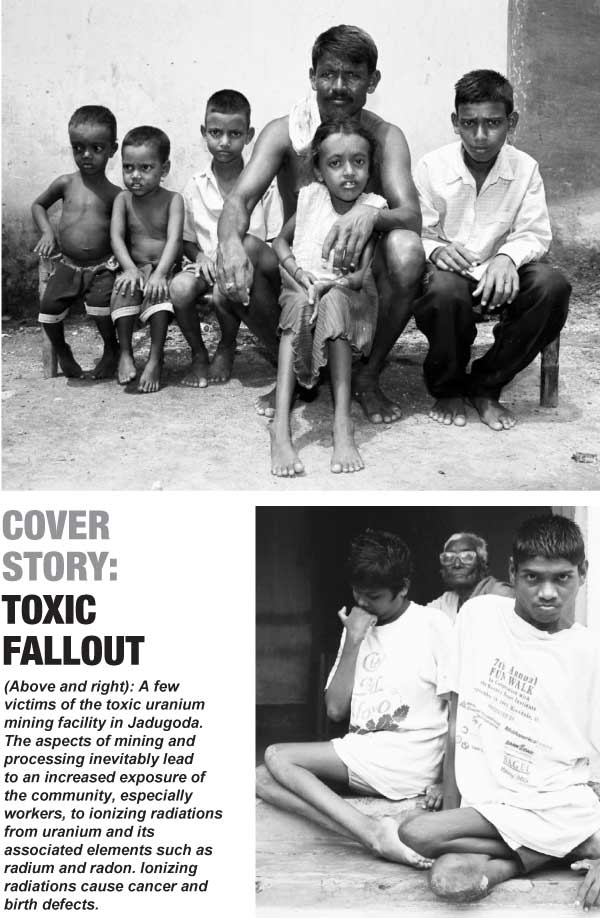
India’s Nuclear Ambitions. India plans to put up a total installed nuclear power capacity of 20,000 MWe by the year 2020. India has 14 reactors in operation and has an installed nuclear capacity of 2720 MWe. At present eight reactors are under construction and, when completed, will add 3960 MWe to the nuclear installed capacity. With such ambitious plans and thrust on nuclear power as a future source of sustainable “green” energy and fresh impetus from the Indo-U.S. nuclear deal, many more uranium mines and nuclear plants are on the horizon. UCIL is engaged in mining and milling of uranium ore at Jadugoda, Bhatin and Narwapahar at Singhbhum district of Jharkand. Techno-commercially viable deposits are reported to have been found at Turamdih, Bagjata and Banduhuran in Jharkhand, Lambapur and Peddagattu in Andhra Pradesh and Domiasiat in Meghalaya.
Struggle Continues. Though some clean-up effort has been taken up by UCIL, the there are no alternatives for villagers to escape this radioactive fallout. Most of these poor villagers are already displaced from their lands more than once. They do not have any access to safe drinking water, and the creek, which got poisoned after the spill, was their only source of water. Even in these circumstances, not much is expected from UCIL to help this poor community. The perseverance and struggle of the Jadugoda community has led to international recognition of their problems. They have connected with other indigenous communities from all over the world, suffering the similar fallout of uranium mining. In December 2006 indigenous peoples from around the world who are victims of uranium mining, nuclear testing, and nuclear dumping came together at the Navajo Nation for the Indigenous World Uranium Summit, which called for a global ban on uranium mining on native lands. Representatives from Jadugoda gave testimony about the alarming number of babies who are stillborn or are born with serious birth defects, and of the high rates of cancer that are claiming the lives of many who live near the uranium mines.
The people of Jadugoda are not alone in this fight, even though the Indian government or UCIL may choose to ignore their plight. The recent spill and its mishandling by UCIL has drawn flak from the global community, and 400 individuals have signed petitions circulated by two U.S.-based groups, the Association for India’s Development and FOSA.
More information on Jadugoda is available at www.jadugoda.net
|TOP|
AWARD:
Battling Arsenic: The NAE Awards
Bangladesh-born scientist Abul Hussam has won a $1-million prize for developing the technology for removal of arsenic from groundwater. A team led by India-born scientist Arup Sengupta won the $200,000 second prize for a separate technology. A Siliconeer report.
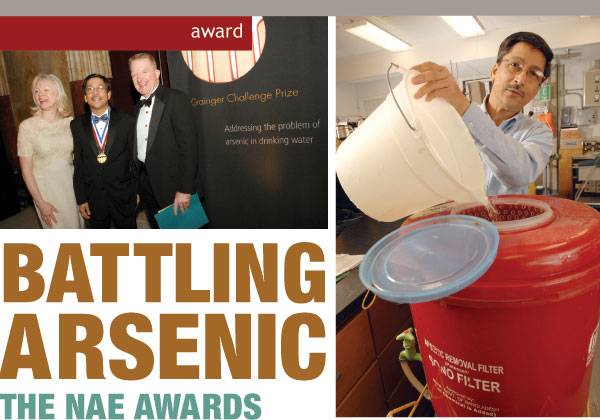
(Above, right): George Mason University chemistry Prof. Abul Hussam at work in his lab on his novel technique for arsenic remediation. He won the $1 million Grainger Challenge Gold Award from the National Academy of Engineering for his solution for removing arsenic from drinking water, a problem affecting tens of millions of people in West Bengal and Bangladesh.
(Above, Left): Abul Hussam (c) at the awards reception in Washington D.C. after receiving his medal with G.J. Sinclair, vice president and secretary of the Grainger Foundation and Admiral William B. Hayden, vice president of the Grainger Foundation. (Evan Cantwell / George Mason University photos)
Bangladesh-born Abul Hussam, an associate professor in the department of chemistry and biochemistry at George Mason University, Fairfax, Va., has received the Grainger Challenge Gold Award of $1 million for his SONO filter, a household water treatment system that removes arsenic from groundwater.
The National Academy of Engineering announced recently the winners of the 2007 Grainger Challenge Prize for Sustainability. The contest sought innovative solutions for removing arsenic from drinking water that is slowly poisoning tens of millions of people in developing countries. Three prizes were awarded from a field of more than 70 entries.
In an announcement, the NAE said: “The prize winners are recognized for the development, in-field verification, and dissemination of effective techniques for reducing arsenic levels in water. The systems must be affordable, reliable, easy to maintain, socially acceptable, and environmentally friendly. All of the winning systems meet or exceed the local government guidelines for arsenic removal and require no electricity.”
The prizes were presented at a gala dinner in Washington, D.C., Feb. 20.
A team led by India-born Arup SenGupta, professor of chemical engineering and of civil and environmental engineering at Lehigh University in Bethlehem, Pa., won the Grainger Challenge Silver Award of $200,000 for their community water treatment system.
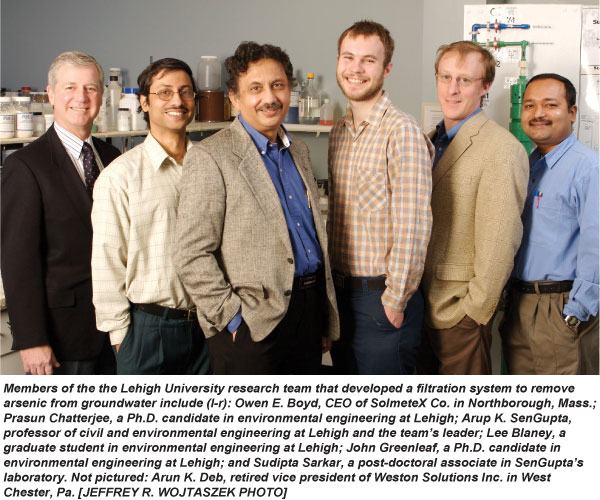
SenGupta, John E. Greenleaf, Lee M. Blaney, Owen E. Boyd, Arun K. Deb, and the nonprofit organization Water For People shared the award.
The Children’s Safe Drinking Water Program at Procter & Gamble Co., Cincinnati, will receive the Grainger Challenge Bronze Award of $100,000 for the PUR Purifier of Water coagulation and flocculation water treatment system.
Arsenic contamination is prevalent in neighboring Bangladesh and West Bengal, India, where a quarter of the population drinks water from shallow tube wells — an inexpensive, low-tech way of accessing groundwater. Many of the estimated 10 million tube wells were built to provide an alternative to bacteria-tainted surface water. Unfortunately, these wells frequently tap into aquifers contaminated by arsenic.
Arsenic poisoning is a slow, painful process that can ultimately result in cancer and death. Debilitating sores appear first and are followed by nerve damage, often in the hands and legs, which are especially sensitive to arsenic. Affected people can have difficulty working or even walking, and continued exposure can lead to liver failure, kidney failure, and the amputation of arms or legs.
For Abul Hussam, the arsenic threat hit close to home. About 10 years ago, his brother, a medical doctor in Bangladesh, started to see the frightening consequences of arsenic poisoning in his village. He asked Hussam to help develop a way of measuring the arsenic levels in wells.
Hussam did his PhD work in analytical chemistry at the University of Pittsburgh. Developing an instrument to measure arsenic levels in drinking water was a perfect match for his interests.
He started with his own family’s well in Bangladesh. To his shock, he learned his family had been drinking water with three times the toxicity level of arsenic for more than 20 years, and there was a possibility his own father had died from arsenic poisoning.
“Measurement is absolutely critical — it is my strength and what brought me to this project – but once you know what you have, now the question is, ‘What can we do about it?’” says Hussam.
That’s when Hussam started looking at ways to build a filter to help provide safe drinking water for his family and neighbors. The challenges required looking at issues such as economy, environment and efficiency. Because Bangladesh is a developing country, the filter had to be inexpensive. Hussam also had to ensure that the materials used were safe for the environment and easy to obtain and reproduce.
After years of research and testing, Hussam and his brothers developed the SONO filter. Simple, inexpensive and made with easily available materials, the filter involves a top bucket, which is filled with locally available coarse river sand and a composite iron matrix (CIM). The sand filters coarse particles and imparts mechanical stability, while the CIM removes inorganic arsenic. The water then flows into a second bucket where it again filters through coarse river sand, then wood charcoal to remove organics, and finally through fine river sand and wet brick chips to remove fine particles and stabilize water flow.
SenGupta was asked in 1995 by the nonprofit organization Water For People to design an arsenic-removal system. SenGupta’s laboratory is credited with developing and commercializing the first polymer-based arsenic-selective adsorbent. This technology has been employed in the Indian subcontinent and in more than 200 sites in the U.S. to remove arsenic from contaminated groundwater.
His filtration systems have been installed in 150 villages by students and professors from Bengal Engineering and Science University. Arsenic levels in the villages’ drinking water have fallen from 100 to 500 parts per billion (ppb) to well below the 50 ppb maximum allowed by the Indian government. Victims have found relief from their symptoms, and reports of new cases of arsenicosis have plummeted.
|TOP|
NEWS DIARY: February 2007 Roundup
 India Steps Up War on Poverty in Budget | Kite Festival a Battle for Pakistan’s Soul | Cheney Survives Taliban Suicide Bomber Attack | Sexy Maoist | ‘Modern-day Nero’ | Over the Moon | Dhaka Fire Kills 3 | Fight against Diabetes | Land, Sea Battles in Sri Lanka | Samjhauta Passengers Overcome Fear India Steps Up War on Poverty in Budget | Kite Festival a Battle for Pakistan’s Soul | Cheney Survives Taliban Suicide Bomber Attack | Sexy Maoist | ‘Modern-day Nero’ | Over the Moon | Dhaka Fire Kills 3 | Fight against Diabetes | Land, Sea Battles in Sri Lanka | Samjhauta Passengers Overcome Fear
India Steps Up War on Poverty in Budget
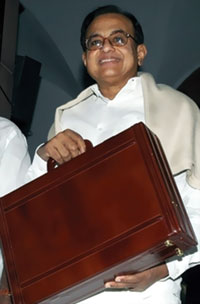 P. Chidambaram P. Chidambaram
India stepped up its war on poverty in a budget unveiled Feb. 28 that aimed at boosting stagnant farm output and raising spending on education and health.
“The economy is in a stronger position than ever before,” Finance Minister P. Chidambaram told parliament as he presented the ruling Congress coalition’s budget for the fiscal year to March 2008.
“I have put these revenues (from growth) to good use to promote inclusive growth, equity and social justice,” said Chidambaram whose government has pledged to put the “common man” at the top of its agenda.
But quoting India’s first Prime Minister Jawaharlal Nehru, he said: “The main challenge is agriculture — everything else can wait.”
He outlined plans to hike farm production and rural incomes and said he was confident the government could wrestle down inflation hovering at two-year highs of 6.6 percent.
Both farm output and inflation have become urgent issues with polls looming in India’s politically pivotal and most populous state Uttar Pradesh in two months and federal elections at most two years away.
Congress attributed its losses in polls in the breadbasket state of Punjab and northern Uttaranchal partly to voter anger over rising prices which have badly hit India’s poor masses who propelled it to power in 2004.
Chidambaram announced more spending on irrigation, fertilizer subsidies, seed development and cheaper farm credit along with duty cuts on a host of goods including edible oils to combat inflation.
“There is no death of (agriculture) schemes, no dearth of funds. What needs to be done is achieve the intended outcome,” Chidambaram said.
|Back to NEWS Diary| |TOP|
Kite Festival a Battle for Pakistan’s Soul
 Residents flying kites in Lahore to mark the arrival of spring. Residents flying kites in Lahore to mark the arrival of spring.
Pakistan’s spring kite festival has become the battleground between the forces of moderation and extremism after the deaths of 14 people including a child.
Islamists have called for the banning of the Basant festival which took place at the weekend in Lahore and surrounding Punjab province — while secularist President Pervez Musharraf personally participated in the event.
“This is a very bad battleground because the forces of moderation are apparently in favor of people being killed while the forces of extremism are unlikely defenders of their right to live,” political analyst M.A. Niazi said.
The failure of the government to control the law and order problem has spoilt the case for the festival, Niazi told AFP.
Basant is traditionally the occasion for posh events and parties in central Pakistan but the kite-battles fought between ordinary people on their rooftops are the occasion’s centerpiece.
Most years there are around a dozen fatalities and this year was no exception.
Police said celebratory aerial firing claimed several casualties while a seven-year-old child died when his neck was severed by a banned glass-coated nylon kite string.
The boy was driving home on a bicycle when a falling string caught between two lampposts cut his throat, police officer Mohammad Zafar said.
Islamic fundamentalists have long opposed Basant on the grounds that it has Hindu or pagan origins.
This year, however, they held protests focusing on the deaths.
“Just like Roman emperors used to put people in front of lions in the ring and call it sport, Musharraf is doing the same with the people in the name of Basant,” said Farid Piracha of the Jamaat-e-Islami party.
|Back to NEWS Diary| |TOP|
Cheney Survives Taliban Suicide Bomber Attack
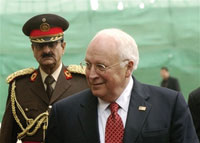 U.S. Vice President Dick Cheney in Afghanistan. U.S. Vice President Dick Cheney in Afghanistan.
A suicide bomber killed and wounded some two dozen people outside the main U.S. military base in Afghanistan Feb. 27 during a visit by U.S. Vice President Dick Cheney. The Taliban claimed responsibility and said Cheney was the target.
The blast happened outside the base at Bagram, north of the capital, Kabul. Cheney’s spokeswoman said he was fine, and the U.S. embassy said the vice president later met with President Hamid Karzai in Kabul.
There were conflicting reports on the death toll. Provincial Gov. Abdul Jabar Taqwa said 20 people were killed, but NATO said initial reports indicated only three were killed, including a U.S. soldier, a South Korean coalition soldier and a U.S. government contractor whose nationality wasn’t immediately known. NATO said 27 people were also wounded.
It was unclear why there was such a large discrepancy in the reports.
Associated Press reporters at the scene said they had seen at least eight dead bodies carried in black body bags and wooden coffins from the base area and into the market area, where hundreds of Afghans had gathered to mourn.
Maj. William Mitchell said it did not appear the explosion was intended as a threat to the vice president. “He wasn’t near the site of the explosion,” Mitchell said. “He was safely within the base at the time of the explosion.”
However, a purported Taliban spokesman, Qari Yousef Ahmadi, said Cheney was the target of the attack.
“We knew that Dick Cheney would be staying inside the base,” Ahmadi told AP telephone from an undisclosed location. “The attacker was trying to reach Cheney.”
|Back to NEWS Diary| |TOP|
Sexy Maoist
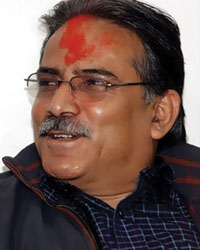 Nepal’s Maoist leader Prachanda Nepal’s Maoist leader Prachanda
Pop quiz: Who is the biggest sex symbol in Nepal? If your answer is, Rajesh Hamal, one of the top paid film actors in Nepal, you are wrong.
After Nepal’s decade-old insurgency ended with a peace pact, it’s Maoist chief Prachanda who is making ladies swoon.
A women’s magazine has readers naming Prachanda as one of the sexiest men in Nepal.
A woman even told Nari magazine that she found the chairman’s moustache — like Hitler’s but with a higher smattering of grey — “very sexy.”
Eat you heart out, Rajesh Hamal.
After 14 years in exile, the reappearance of the agriculture graduate and former schoolteacher in public creates a response that can outmatch the fan appeal of any film star.
Prachanda’s first public appearance at Prime Minister Girija Prasad Koirala’s official residence, after his once banned party signed a peace pact with the government, created a near stampede.
Even after frequent public appearances since then, the Maoist chief continues to be the centre of all attention wherever he goes.
Last month, when Koirala hosted a tea party in honor of the new constitution, the Maoist chief’s entry made the media desert other leaders including the prime minister. Everyone made a beeline for the rebel leader.
Prachanda, who is ready to speak his mind on most issues, has remained silent on this new phenomenon.
|Back to NEWS Diary| |TOP|
‘Modern-day Nero’
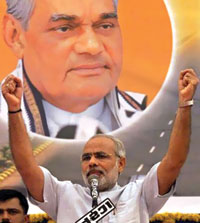 Narendra Modi Narendra Modi
He was accused of being a “modern-day Nero” who sat back while thousands of Muslims were butchered, but Narendra Modi has not only survived as chief minister of India’s western state of Gujarat, he has prospered.
Middle-class Hindus in Gujarat have put behind them the horrific communal riots of 2002 as they grow richer in a state that has become a model of economic development and attracted investment from India’s biggest industrialists, analysts say.
“The middle-class attitude is shorn of any moral compunction when it comes to the riots,” said Gagan Sethi, head of the Center for Social Justice, a local group fighting for the riot-affected. “Their apathy has only emboldened Modi.”
Human rights groups say some 2,500 people, mostly Muslims, were beaten or burned to death in Gujarat five years ago, although officials put the toll at about 1,000.
The riots erupted after a fire broke out on a train carrying Hindu pilgrims on February 27, 2002, killing 59 people.
India’s Supreme Court compared Modi to Roman Emperor Nero, remembered as playing his lyre while Rome burned. Modi’s Hindu-nationalist government looked elsewhere while innocent people were burning and was probably deliberating how to protect the killers, it said in a 2004 judgment.
The United States revoked a visa for Modi the following year, on the grounds that he was responsible for severe violations of religious freedom. “Industry doesn’t concern itself with questions of political morality or ethics or even justice,” said Zoya Hasan, an eminent academician and member of the National Commission on Minorities.
|Back to NEWS Diary| |TOP|
Over the Moon
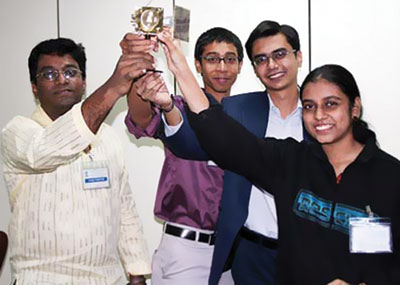 Uday Kumar, Animesh Behera, Amarah Ahmed and Kaushik Parmar Uday Kumar, Animesh Behera, Amarah Ahmed and Kaushik Parmar
As India plans its first mission to the moon, Rediff.com India decided to ask its readers what a mooncraft would look like, and the news Web site and the Indian Space Research Organization have announced seven winners of “Design a Mooncraft,” a competition inviting Rediff.com readers to send their designs for the first Indian mooncraft.
ISRO plans to send a spacecraft, the Chandrayaan, to the moon in 2008.
The winners are: Uday Kumar, 34, an NIT-Raipur-trained architect, who designs apartment buildings and IT buildings in Thiruvananthapuram (first prize); Animesh Behera, 23, an IIT-Bombay electrical engineering graduate, who works for Texas Instruments, Bangalore (second prize); Amarah Ahmed, 15, a student of B P Indian Public School, Malleswaram, Bangalore, who is studying for her ICSE exams (third prize); Kaushik Parmar, 23, a fourth year IIT-Bombay student, studying aerospace engineering (fourth prize); and Aristo Xavier Coutinho, B.K. Nagaraaj, K. Veera Raghavaiah (all fifth prize winners).
The first four winners received their prizes from ISRO chairman Dr. G. Madhavan Nair, at the ISRO headquarters in Bangalore. The prize ceremony was followed by a tour of ISRO and high tea with Nair.
Each of the seven winners received Rs. 10,000 in Rediff shopping vouchers.
Presenting the awards, Nair, Chairman, ISRO said, “Chandrayaan-1, which is planned to be undertaken during 2008, will be an important program that will provide immense opportunities to the younger generation to undertake challenging pursuits in space science and exploration.”
|Back to NEWS Diary| |TOP|
Dhaka Fire Kills 3
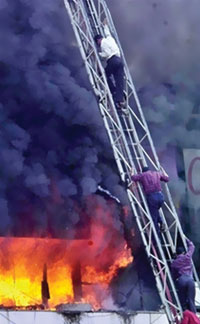 Survivors escaping a building fire in Dhaka. Survivors escaping a building fire in Dhaka.
A fire swept through a building that houses two private TV stations and a newspaper in Bangladesh’s capital Dhaka, killing at least three people and injuring scores, rescuers and news reports Feb. 26.
Air force helicopters, troops and firefighters rescued dozens of people from the building in Kawranbazar, a crowded commercial district in central Dhaka, ATN Bangla TV station reported.
A man and a woman died after jumping from the building to escape the fire, doctors said. Another woman who suffered serious burns died later at a hospital, the United News of Bangladesh said.
Maj. Asadul Haq, an army officer overseeing the rescue operation, told the news agency that at least 100 people were injured in the fire, most in jumps from the building.
It was not immediately known what caused the fire, but officials were investigating.
The TV stations and the newspaper in the building are owned by Mossadek Ali, a former lawmaker recently jailed on corruption charges.
|Back to NEWS Diary| |TOP|
Fight against Diabetes
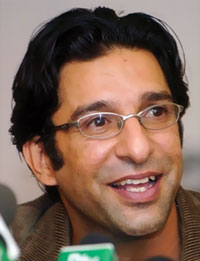 Wasim Akram Wasim Akram
Former Pakistan cricket star Wasim Akram said he was setting up an organization to spread public awareness about diabetes and how patients should counter it.
The former left-arm paceman, himself a diabetic, announced a seven-member committee which includes his former captain and cricket legend, Imran Khan.
“We would raise funds through charity matches between Pakistan and Indian film stars, and the first match of this (kind) will be played in Dubai on April 6 this year,” Wasim told AFP.
Wasim, who took a world record 502 one-day wickets and 414 Test wickets during his career, was hit by the disease in 1997 but managed to continue playing until 2003.
He said a study revealed Pakistan would have the world’s fourth-largest population of diabetes sufferers by 2025, and his foundation would fight to minimize this in the coming years.
“Around 80 percent of sufferers don’t know they have this disease, so we want to create awareness and then help them fight it,” said Wasim, now a commentator with a Hong Kong-based television company.
|Back to NEWS Diary| |TOP|
Land, Sea Battles in Sri Lanka
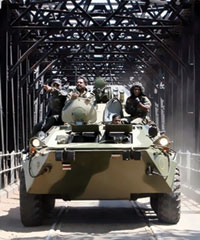 A Sri Lankan Army tank on patrol. A Sri Lankan Army tank on patrol.
Sri Lanka escalated sea and land attacks against Tamil Tigers and killed at least 18 people Feb. 28, a day after the rebels shelled helicopters carrying diplomats and a minister, officials said.
The navy engaged a flotilla of rebel boats off the northeastern coast in a pre-dawn clash, sinking two craft together with at least 15 people, navy spokesman Commander D.K.P. Dassanayake said.
The three-hour confrontation with the Liberation Tigers of Tamil Eelam off Pulmoddai wounded at least two navy sailors, he said.
“There were about 14 Sea Tiger boats. The navy destabilized two of the boats. We believe about 15 to 16 people were there in the two boats that were destroyed,” Dassanayake said.
In southern waters, naval patrol craft fired at a “large ship” which exploded and burnt for over two hours, Dassanayake said.
“We contacted the vessel on radio and the information they gave us turned out to be wrong,” he said. “The vessel had no identification marks and after we fired warning shots, they began to attack our patrol craft. We retaliated.”
He said the 75-metre (250 feet) long vessel was believed to be carrying a large haul of arms for the Tigers. However, there was no immediate word from the rebels.
Military spokesman Prasad Samarasinghe said three suspected Tiger rebels were also shot dead by a foot patrol of the elite police Special Task Force commandos in the northwest district of Mannar early Feb . 28.
The land and sea battles came a day after the Tigers shelled two military helicopters carrying ambassadors from France, Germany, Italy, Japan, the United States, European Union and the heads of UN agencies.
The Italian and US ambassadors as well as the UN resident coordinator were among more than a dozen people wounded in the attack in the eastern town of Batticaloa, 300 kilometers (187 miles) east of the capital by road.
|Back to NEWS Diary| |TOP|
Samjhauta Passengers Overcome Fear
Hundreds of passengers overcame fear and strict security checks March 1 to travel by rail from India to Pakistan, the first journey on the route since 68 people were killed when a train was bombed.
Two bombs exploded around midnight Feb. 25 on the Samjhauta Express, which connects New Delhi to Lahore in Pakistan, triggering a blaze in two coaches that burned victims alive about 80 km (50 miles) north of the Indian capital.
“All of us have to die someday. There is no need to be scared,” said Ameena Bano, a 63-year-old Pakistani woman, sitting on a large blue bag near the platform before boarding the train in Delhi’s chaotic station.
Bano, who had been visiting her brother-in-law in India, said those behind the blasts would not achieve their goal.
“They want to hurt the improving relations between Pakistan and India but they will not succeed,” she said, as people carrying suitcases pushed their way through security barricades.
Although the old rivals are linked by air and bus services as well, the bi-weekly train is more popular with the mostly middle-class and poor travelers as it is cheaper. Besides, it was relatively less guarded by security agencies.
It is for these reasons, investigators suspect, the train may have been targeted by Muslim extremists who are opposed to a peace process between the neighbors and want to derail it.
|Back to NEWS Diary| |TOP|
|